Courland Pocket/Fortress II WW2
The Courland Pocket or Courland Fortress or Courland Cauldron (Latvian: Kurzemes katls, Kurzemes cietoksnis, German: Kurland-Kessel, Kurland-Festung; Russian: Курляндский котёл, блокада Курляндской группировки войск) designates the territory of the Kurzeme and partly Zemgale regions where, during World War II, from October 1944 to May 1945, the German Army Group North, later renamed to Army Group Kurzeme, was cut off by the 1st and 2nd Baltic fronts of the Red Army.
Courland Pocket and Courland Fortress were used for propaganda purposes during WWII.
Your comments
Related objects
Saldus German Soldiers' Cemetery
Saldus German soldier's cemetery is located on the Saldus-Ezere highway. Around 25,000 German soldiers, as well as some Latvian legionnaires, were reburied in the 8-hectare cemetery. Reburial has been taking place since 1997.
From May 1 to October 1, an exposition on the Battle of Kurzeme can be seen in the memorial room. During this period, the memorial room is open on weekdays from 9:00 a.m. to 5:00 p.m., on Saturdays and Sundays the cemetery also has a tour guide. The registers of soldiers buried in Saldus German soldiers' graves and fallen soldiers throughout Latvia are also available.
Private collection of military objects and sewing machines
The only sewing machine collection in Latvia with more than 200 different sewing machines from the pre-war and Soviet periods, which played a direct role in the production of military clothing in the pre-war and war years. Collection creator - Juris Beloivans
Soviet soldiers' cemetery "Tuški"
The fraternal cemetery of the Red Army 130th Latvian and 8th Estonian Rifle Corps soldiers is located about 350 metres south-west of the Blīdene-Remte road. The name derives from the farm Tušķi, which was located 400 m south of the cemetery.
On 17 March 1945, the last attempt of the Red Army in Kurzeme began. The 308th Latvian Rifle Division attacked south-west and west of the Tušķi homestead and during three days of fighting crossed the Blīdene-Remte road in the 142.2 area of the highlands and reached the Jaunāsmuižas-Mezmali line. The soldiers killed during the battles were buried in several small cemeteries near Ķēķiai, Vērotāji, Jaunāsmuiža and elsewhere.
In the late 1960s, when the Soviet Union began to commemorate the Second World War, a new cemetery was established north of the ruins of the Tušķu homestead, where it was planned to rebury all the soldiers who had fallen in the Pilsblidene and Kaulači area. In reality, the reburial was partial, as very often the fallen soldiers remained in their original gravesites, but only their names were overwritten in the cemetery of the Tuški brothers. The names of the soldiers of the 8th Estonian Rifle Corps, whose main wartime cemetery was located on the site of the present Pilsblidene cemetery, can also be found in the Tuški Brethren Cemetery.
There is also a monument to Jakob Kundera, a soldier of the 8th Estonian Rifle Corps, to whom the object 'Kundera dots' is dedicated. Immediately after the battle, Jakob Kundera was buried in what is now Pilsblidene Cemetery, and later reburied in the Tuški Brethren Cemetery.
Rebuilt German army dugouts in Melnsils Campsite
Campsite Melnsils is located next to the sea 10 km from Kolka. Here German Army type dugouts have been built that can be used as lodging for the night. This is a nod to the history of this region when during World War II the German Army had a border guard post and a camp site here and soldiers built dugouts for themselves using materials that could be found nearby. Trenches can still be found in the dunes along the coast.
‘Bunker Nr. 13’ is the largest of the two dugouts, with three bunk beds. The ‘Small Bunker’ is smaller and has two bunk beds. Campsite ‘Melnsils’ is a great choice for active recreation and sporting events for up to 300 people. It is located near the Slitere National Park, coastal bluffs and forest hiking trails. There are marked cycling trails that wind through the natural surroundings in the area. There are designated places for tents and campfires by the sea, as well as barrel-type guest houses for two or four people. A bathhouse with different types of whisks is also available.
Vaiņode station
The railway station building was opened with the construction of the Liepāja-Vainode railway line in 1871. The station building itself was opened in 1872. This was also the beginning of a great activity in the development of the central streets of Vaiņode. It is significant that in the guidebooks of the time, the distance of each building or object was indicated as the distance from the railway station. The railway station was once an important military transport hub.
During the First World War, a branch line was built from the station to the airfield, which brought materials (metal shapes for hangars), cranes, winches and ammunition for war stores, which were then transported by zeppelins to Riga and bombed the Russian fortifications.
The railway station building was not affected by the devastation of World War II and has not changed its appearance over time. Vaiņode station can be seen from the outside.
The military activity in the vicinity of Vaiņode can be traced back to the successful Red Army offensive that began on 5 October 1944 in the vicinity of Šiauliai. Quickly crushing the weak German resistance, Soviet tank units were tasked with seizing the strategically important Liepāja-Shaul railway line. In the early hours of 9 October 1944, the first units of the 79th Tank Brigade of the 19th Panzer Corps and the separate units of the 143rd Tank Brigade launched an offensive. As a result of the collapse of the German front, only small units of the German 61st Infantry Division, supported by armoured trains, were present in the eastern outskirts of Vaiņode. The resistance was quickly overcome and by the evening of 9 October the whole of Vaiņode was under the complete control of the Red Army. On 10 October, units of the 103rd Rifle Corps of the Soviet 6th Guards Army arrived and continued their attacks, pushing back the German 61st Infantry Division 2 km north of the Skaistkalne sanatorium. As the Soviet forces took Vaiņode with little fighting, the Vaiņode station and the town's buildings suffered relatively little.
The fighting got a little closer to Vaiņode on 24 October 1944, when the German 10th Corps, with the 14th Panzer Division in the lead, carried out an offensive operation nicknamed "Eberhard". During the fighting, the front line consolidated just north of the sanatorium and remained there until 27 October, when the Red Army launched an offensive known as the 1st Kurland Bolshoi.
Pilsblidene Manor
The manor house was built in the classical style in the 1920s of the 19th century. After the land reform, the manor complex was rented out to private individuals, but from 1932 it passed to the Ministry of People's Welfare.
6. During the fierce battles of the Great Battle of Courland it was used both as a support post and as an infirmary.
On 17 March 1945, the last attempt of the Red Army to attack Courland began. Units of the German 24th Infantry Division defended themselves in the vicinity of the Pilsblidene Manor complex. On 18 March 1945, the manor house was attacked from the south by the 121st Rifle Regiment of the Latvian Rifle Division of the 43rd Guards, which was unsuccessful. The 1st Battalion of the 300th Rifle Regiment of the 7th Estonian Rifle Division attacked from the west, and at the end of the day the 35th Tank Brigade of the 3rd Guards Mechanised Corps joined the 1st Battalion of the 917th Rifle Regiment of the 249th Estonian Rifle Division on the Blīdene-Remte road.
On the night of 19 March, the 43rd Grenadier Regiment of the 19th Latvian SS Grenadier Division arrived in the vicinity of Blīdene Station and counter-attacked to retake the Pilsblīdene Manor residential building. However, as a result of a night tank attack, Estonian and Latvian units of the Red Army gained a foothold at the station.
In 1959, a fire broke out in the castle. From 1961 to 1986, a retirement home operated in the residential building. In 1986, the castle was again destroyed by fire. Since then, the castle has stood empty and ruined.
A 24-hectare park surrounds the manor house, which is now overgrown. The park has about 37 plantations of non-native species of trees and shrubs and is under state protection. The park is unmaintained and the surroundings are overgrown.
Ezere local history repository “Muitas Nams” (Customs House)
The Ezere Customs House is located in Ezere near the Saldus-Mažeikiai highway at the Latvian-Lithuanian border. The act of surrender of the German Army units ‘Kurzeme’ (Kurland) surrounded in the so-called ‘Courland Pocket’ was signed in this building on 8 May 1945. It is believed that World War II actually ended in Ezere. The customs house has an exhibit covering the events of the end of World War II and exhibits detailing the history of Ezere parish from ancient to modern days. In the morning of 7 May 1945, the commander of the Leningrad Front, Marshal L. Govorov, sent an ultimatum to the command of the army group ‘Kurzeme’ to lay down arms. The act of surrender was signed by the involved parties on May 8 and it detailed the procedure of surrender, weapons collection points, documents and information to be submitted and other practical measures.
Priekule Memorial Ensemble of Warrior’s Cemetery
The Priekule Memorial Ensemble of Warrior’s Cemetery is on the Liepāja-Priekule-Skoda road and is the largest burial site of Soviet soldiers of World War II in the Baltics. More than 23,000 Soviet soldiers are buried here. Operation Priekule was one of the fiercest battles in Kurzeme Fortress that took place from October 1944 to 21 February 1945. The Battle of Priekule in February 1945 lasted seven days and nights without interruption and had a lot of casualties on both sides. Until Priekule Warrior’s Cemetery was transformed into a memorial, the last monument of the outstanding Latvian sculptor K. Zāle (1888-1942) was located here to commemorate the independence battles in Aloja. Between 1974 and 1984, the 8 ha Priekule Warrior’s Cemetery was transformed into a memorial ensemble dedicated to those who fell in World War II. It was designed by the sculptor P. Zaļkalne, architects A. Zoldners and E. Salguss, and the dendrologist A. Lasis.
The centre of the memorial holds a 12 m tall statue called the ‘Motherland’, and names of the fallen are engraved on granite slabs. Until Latvia regained its independence, the Victory Day was widely celebrated every year on May 9.
Pelči Manor
The Pelči Manor is located in Pelči parish, Kuldīga municipality. Tours of the manor house must be booked in advance. The Pelči Manor was built between 1903 and 1904, and this work by architect Wilhelm Neumann is one of the most outstanding manors of the early 20th century in Latvia. Its architectural language involves compositional principles and elements from Renaissance, Baroque and Art Nouveau. Between the late 19th century and 1920, the manor was owned by the Fürst von Lieven family.
From 1944 to 1945, the Pelči Manor was used as headquarters of the German Army Group ‘North’ (known as Army Group ‘Kurzeme’ as of 25 January 1945).
The headquarters of the Army Group ‘North’ moved from Sigulda to the Pelči Manor on 23 September 1944 in view of the planned retreat of the 18th army force from Estonia. The headquarters remained there approximately until mid-May 1945 when, after the capitulation of Army Group ‘Kurzeme’, information and documents were handed over to Red Army officers.
Barn of Nygrande Manor
The Nīgrande Local History Repository is located in the Nīgrande village in the manor barn, next to the Nīgrande Primary School, and is accessible by appointment.
The military history section of the repository includes an exhibition on World War II and original objects and parts found in the area after the war and in later years. You can also find out stories and see photographs about Nygrande and its surroundings from the War of Independence, World War II and the post-war period, as well as life on the collective farm in Soviet times.
The exhibition has a special place for the local writer Jēkab Janševskis and his works, and there is an exhibition presenting traditional manor house life and furnishings. A mammoth tusk found in Nīgrande is also on display in the barn of Nīgrande Manor.
Zlēku Tragedy Memorial Site
The memorial is located near the Zlēki Manor ensemble, in the western part of Karātavkalns. Around twenty boulders with the names of the people killed form a circle, and in the centre is a black marble obelisk about three metres high.
Some of those killed have been reburied at the Zlēki memorial.
In December 1944, in the vicinity of Zlēki, the German Nazi army carried out a large-scale operation against the civilian population.In the combat action log of Army Group Nord, an entry was made at 17.30 on 9 December 1944 that 161 people belonging to the "Rubens Brigade and units of the Red Arrow" had been killed on the enemy side during the action. In Soviet times, this figure was apparently taken as the total number of victims of the Zlēki tragedy, referring to civilians killed.
The course of the action is partly documented in the report of the head of the counter-intelligence section of the German 16th Army of 31 December 1944. It explains that from 5 to 9 December, under the leadership of the highest SS and police leader in Ostland, SS Oberruppenführer and Police General Friedrich Jekeln, a large-scale operation took place at Eichensumpf ("Oak Swamp") against the "Red Arrows" and the remnants of General Kurel's group at Abava.
Boat trip in Ciecere lake by the boat “Zezer”
During the ride with the recreational boat “Zezer” along Lake Ciecere near Brocēni you can listen to the audio guide and captain's stories about Lake Ciecere and the city of Brocēni on its shores, World War II events near Lake Ciecere, trenches on both sides of the lake and the Oak Island, as well as the tank route running along an observation tower and the tank that is said to be sunk in the lake. The audio guide is available in Latvian, Lithuanian, English, and Russian languages. The ride takes 1 hour 15 min.
Memorial sign for refugees "Sail of Hope" in Jūrkalne
The "Sail of Hope" commemorative sign for the World War II refugees who crossed the Baltic Sea by boat to the island of Gotland in Sweden in 1944 and 1945. The memorial is located in Osvalki on the dunes between the sea and Ventspils-Liepaja highway, near the public transport stop "Kaijas". It was created by sculptor Ģirts Burvis, who realised it as a sail of hope symbolising the memory of Latvian refugees.
Between autumn 1944 and spring 1945, fearing the renewed Soviet occupation but unwilling to evacuate to a devastated and threatened Germany, some Latvian citizens tried to reach the nearest neutral country, Sweden, by sea. Some of the boats were organised by the Latvian Central Council with the help of the Western Allied countries, which resulted in one of the largest refugee concentration points in Jūrkalnes parish. Besides the boats organised by the Latvian Central Council, other boats were also taken across the sea. It is estimated that about 5000 persons managed to cross the sea. The number of deaths is unknown, as no records were kept of refugees leaving the Kurzeme coast.
The voyages were dangerous because the refugees were threatened by German patrols on the coast and at sea, sea mines, Soviet aircraft and warships, as well as storms, as the crossings often took place in unsuitable and overloaded cutters and boats without sufficient fuel and food supplies, sea charts and navigational instruments. Departures from Latvia were carried out in secret. The destination of the boats was the island of Gotland, and the journeys most often started on the west coast of Courland (from Jūrkalne to Gotland is 90 nautical miles or about 170 kilometres as the crow flies).
Red Army Soldiers Memorial Site "Pieta" in Nīkrāce municipality
The Soviet Soldiers' Cemetery is located on the Skrunda - Embute - Priekule road, which is situated on a highland between the two rivers Dzelda in the south and Koja in the north. More than 3000 fallen are buried there.
World War II battles
The Red Army launched an offensive operation from 27 October 1944, now known as the 1st Kurland Battalion, with the aim of destroying the German army group "North", later renamed "Kurland". By 5 November, the Soviet 61st Army and parts of the 6th Guards Army and the 4th Shock Army reached the River Zeld and some units of the 5th Guards Panzer Army captured the bridgeheads on the north bank of the river. Before the next attack, the 2nd Guards Army of the 1st Baltic Front was moved into this sector to reach the Skrunda-Liepaja railway line. After the initial invasion was achieved, the attack towards Kuldīga would be continued by the 5th Guards Panzer Army.
The start of the 2nd Battle of Courland was delayed by weather conditions and only began on 19 November. The Red Army made its greatest gains in the vicinity of what is now the Cemetery of the Brothers and by the evening of 24 November the 1st and 60th Rifle Corps had captured the placdarm on the north bank of the River Koj. However, the Red Army's success ended there. The German Army Group North anticipated the direction of the Soviet attacks and concentrated appropriate forces here, including two panzer divisions.
On the evening of 26 November 1944, the Red Army attacks were halted and no further attempts were made to destroy the German forces in Courland until the end of the Second World War. In the battles that followed, the task was to prevent the German army from being evacuated from Courland.
Monument to the 8th Estonian Rifle Corps of the Red Army
The monument to the soldiers of the 8th Estonian Rifle Corps of the Red Army is located at the ruins of the Kaulači half-manor farmhouse about 100 metres south-west of the road.
On 17 March 1945, the last Red Army offensive attempt in Courland began. The task of the 7th Estonian Rifle Division of the 8th Estonian Rifle Corps was to reach the Riga-Liepaja railway line west of Blidene station and to secure the attack of the 3rd Guards Mechanised Corps in the direction of Gaiki. By the evening of 17 March, the 354th Rifle Regiment reached the railway south of Kaulači half-manor through the forest and continued its attacks north-westwards, reaching the Pikuliai houses. In the Kaulači semi-mansion and further to the north-east were the German Burg-Stellung positions, defended by individual units of the 329th Infantry Division. Throughout the day of 18 March, attacks by the 354th Rifle Regiment continued unsuccessfully.
On the evening of 18 March the 354th Rifle Regiment was relieved by the 27th Rifle Regiment. The advance unit of the 7th Mechanised Brigade of the 3rd Guards Mechanised Corps, the 1st Motorised Battalion, with one tank company, was also to be used for the attack. By the evening of 19 March, in a concentrated attack, the Soviets had captured the Kaulači half-manor, seizing a section of the German-built defensive line on the dominant high ground.
Until the end of March 1945, attacks by the 8th Estonian Rifle Corps and the 3rd Mechanised Corps in the directions of Vikstraute and Remte continued, but without success.
During the fighting, the Kaulači half-manor housed various levels of headquarters and a memorial stone was unveiled on the site in May 1975.
Collection of old cars "Retroknifiņš"
There is also a private collection in Zvārde municipality that contains both cars and trucks, as well as motorcycles.
The collection includes a restored German army BMW motorcycle, which was already here during the siege of the german army group "Kurland", as well as several German cars that remained here after the surrender of the German army group "Kurland".
This collection was created by enthusiast Jānis Dobelis. If you make an appointment in advance, the owner is ready to welcome you and give you a full description of each of the exhibits.
Horseback riding and horse riding tours around Paplaka and Priekule
The thematic horse-drawn carriage tours offered by the owner of the Stiebriņi farm, such as a horse-drawn carriage ride on a railway embankment, listening to a guide talk about the industrial heritage, are a great adventure. A horse-drawn carriage ride through the sites of the former military garrisons/towns around Paplaka will also be unforgettable. We particularly recommend the children's playground of the Soviet army housing estate, known locally as "Disneyland", the Finnish cottages (a Finnish wartime contribution to the Soviet Union), the water towers and the ruins of the former luxurious buildings of Barons fon Korfs.
German army coastguard searchlight site in Usi and border guard post in Kolka
No military infrastructure was planned in Cape Kolka, except for several offshore lighthouses that were rebuilt over a long period of time, either before World War I, during World War I or during World War II. Coastal defence batteries were planned for the narrowest part of the Irbe Strait, between the Sirves Peninsula and the Michael Tower Lighthouse.
The only fortifications of a military nature appeared at the end of 1944, when the German Army Group North was preparing to repel possible landings by the Soviet Baltic Fleet. In the spring of 1945, after the ice retreated, two batteries of the 532nd Artillery Division defended the coast at Cape Kolka. Battery 7 with four 75 mm guns and three 20 mm zenith guns. Battery 8 with four 88 mm mortars, three 20 mm mortars and an 81 mm mortar. The anti-deserter infantry garrison consisted of one of the most famous coastal defence units of the German Navy, the 5th Company of the 531st Artillery Division. Although it was an artillery unit by name, it was an infantry unit by deployment, which started its war in June 1941 at Liepāja. The unit was then garrisoned on islands in the Gulf of Finland and later took part in the fighting on the island of Saaremaa. The remnants of the division were reformed into one company and, reinforced with seven anti-tank guns and three 20 mm anti-aircraft guns, deployed at Cape Kolka.
The Soviet naval landing operation never took place and the German units capitulated in May 1945.
The military infrastructure in Cape Kolka began to be built after the Second World War, when Soviet border guard posts were deployed here and Kolka, like the entire Kurzeme coast from Mērsrags to the Lithuanian border, became a closed zone
German Army concrete tower (by the beach)
Walking along the slope of Mount Odju for 200 m along the path, you can see several objects related to the First World War - old concrete foundations of cannons from. An unfinished concrete observation tower stands next to the beach, parallel to the forest path along the Rojas Trail. The exact use of this object is unknown. Below the base, niches have been built for ammunition. Deep pits, former dugouts, are also visible among the pines.
Some of the objects probably date back to the end of the Second World War, when German coastal defence batteries were stationed in the area. The 4th Battery, 532nd Artillery Division, Navy, was armed with four 88 mm guns, three 37 mm guns, one 20 mm four-barrelled gun and one 50 mm mortar for illumination at night. Two 45 mm anti-tank guns are deployed at the mouth of the Rojas. The town garrison consisted of units of the 64th and 109th Sapper Battalions.
Ruins of Ķērkliņu church
The ruins of the Ķerkliņu Church are located about 5 kilometres north-west of Kokmuiža, near the Ķerkliņu Lake. The church was built in 1641 by Heinrich von Dönhoff (Derkarth), the owner of the Ķerkliņi manor. The original wooden church was replaced by a stone building, under which tombs were built for the dead of the Dönhof and later Kleist families. The tombs were already destroyed during the 1905 riots, but in 1949 the coffins were moved from the tombs to the church. The church was an example of the Kurzeme Baroque style - its carvings were made by the Kuldīga - Liepāja woodcarvers. Although the owners of the manor and the church were at various times plagued by financial problems, the church underwent several reconstructions during its existence. It also suffered during the First World War, after which the parish rebuilt the stonework in 1929 and added an organ in 1934. Unfortunately, the church was damaged during the Second World War and much of it was lost, so it is to be commended that before the church was rebuilt in 1933, many unique pieces of Baroque sculpture were photographed, inventoried and even ended up in the archives of the Monuments Board. With the establishment of the landfill and the eviction of the inhabitants, the church was never restored. Today, the church walls and tower are visible.
Virga manor antiquities storage
A storage room for antiques has been arranged in the house of the lords of the Virga manor. Here you can get an idea of who lived on the banks of the Vārtajas River and in Virga, as well as the Virga estate and the Nold family of barons, as well as the times of World War II and the Soviet kolkhoz in Virga. You can only look at the objects, but you can also listen to stories about topics that are interesting to visitors.
The Virga manor survived the Battle of the Kurzeme cauldron in 1944/1945 so well that a simple walk through the territory of the former manor allows you to perceive the breath of antiquity and the presence of the former inhabitants of the manor. A moment of rest at the "Karlias Zabaks" memorial of the Swedish king Charles XII or at a specially designed resting place near the Virga Tradition House will be useful not only for relaxation, but also as a reminder that Charles XII spent the winter of 1701 right here - in Virga.
In the former granary of the manor, now in the house of cultural and domestic traditions of local residents, you can rent a sauna and rooms for celebrations, including weddings.
Pampali church and the walls of the destroyed house
Pampāļi is a settlement in Pampāļu parish of Saldus county, the center of the parish is on the banks of Zaņas and its tributary Abrupe, 27 km from the county center Saldus and 147 km from Riga. The settlement was formed around the center of Pampāli manor after the agrarian reform. In 1933, Pampālis was granted the status of a densely populated place.
The hostilities on the outskirts of the Pampali began on November 21, 1944, when the Soviet 4th shock army, forcing Venta, began an attack in the direction of Saldus. By November 24, the situation stabilized and the front line remained unchanged until December 21.
On December 21, 1944, the so-called 3rd Battle of Kurzeme began, during which the 4th shock army of the 1st Baltic Front with 4 rifle corps (12 rifle divisions) and the 3rd Guards Mechanized Corps attacked in the direction of Saldus to connect there with the 2nd Baltic Front units. The German 132nd Infantry Division, whose 1st Battalion of the 436th Grenadier Regiment had fortified itself in the vicinity of the manor and the church, was defending itself in the Pampali district.
The attack on Pampāliai was carried out under the support of massive artillery fire by the 357th and 145th Rifle Divisions of the 1st Rifle Corps, supported by the 39th Guards Tank Brigade. During the first 24 hours of the battle, the Pampali garrison, commanded by the commander of the 14th (Anti-Tank) Company of the 436th Grenadier Regiment, Captain Eberard Coll, was encircled and virtually destroyed in fierce fighting.
Since Pampali was located right on the front line, all the buildings were hit by artillery fire and practically have not been preserved today.
Private military collection in Mundigciems
Private military collection in Mundigciems. Aivars Ormanis has been collecting historical objects for many years - military uniforms, uniforms, camouflage, communication devices, household items, protective equipment from different periods and countries, dating back to the Second World War, the Soviet army and the restoration of independent Latvia.
The collection is currently not well maintained and the exhibits are housed in a former collective farm barn.
Memorial site for Hermann Faul
It is located at the crossroads of rural roads, turning off the road leading from Pienava to Džūkste.
Memorial to H. Faul, and to the nine German and Latvian soldiers who fell in the battle of 27 December 1944 (probably blown up by a direct hit from a cannon shell) and who are presumed missing since then, as no remains, documents or other evidence of their identity have been found.
Otanki Antiquities Store
The Otanki local museum is located in the yard of the former Rude school.
The guide's narration about the bunker and its creators, their further fate. A model of the bunker created by the students of the former Rude school (according to the partisans' own narrative) and a spatial map of the forest area of those times with marked houses of supporters and contacts can be viewed. Bunker household exhibits collected.
Advance application by phone 26323014 or email lelde.jagmina@gmail.com.
Evidence of the 2nd World War in Aizvikai Park
Aizvīkai Manor Park is located in Aizvīki, Gramzda Parish, just a few kilometers from the Lithuanian border.
The places of bunkers and trenches from the 2nd World War are still clearly visible in Aivvikai Park. One of the types of weapons was the Katyusha rocket launch system. Several such Rocket Launching Systems were located in Aizvīki Park, even after the end of the 2nd World War, and these places (caponieri) are clearly visible in nature.
This unique forest park, shrouded in secrets and legends, was created at the end of the 19th century as the Aizvīkai Manor Park, when the baron of the manor von Korff covered the nearby hilly land with a pine and spruce forest. Later, walking paths were laid on the 40 ha area, trees of other species were also planted and a pheasant garden was established.
In addition to the picturesque forest landscapes, there are also fairy-tale and fairy-tale figures made of wood, as well as stone sculptures, which tell travelers about events from the history of Aizvīkai and mark the cultural and historical places in the park. A Green Class has also been created in the park.
In order to get to know the cultural and historical heritage of Aizvīkai Manor Park more fully, we recommend using the services of a guide.
Bunker of the Red Army and caponiers in Aizvīkai Park
Aizvīkai Manor Park is located in Aizvīki, Gramzda Parish, just a few kilometers from the Lithuanian border.
The places of bunkers and trenches from the 2nd World War are still clearly visible in Aivvikai Park. The Red Army bunker has been restored in the park.
One of the types of weapons during World War II was the "Katyusha" rocket launch system. Several such Rocket Launching Systems were located in Aizvīki Park, even now these places (caponieri) are clearly visible in nature.
In order to get to know the cultural and historical heritage of Aizvīkai Manor Park more fully, we recommend using the services of a guide.
Memorial to the artillery regiment of Major J. Ozola
A memorial sign has been installed for the division of Major Jānis Ozolas on the side of the Riga - Liepāja highway, in Džukste parish, about one kilometer from the Kurzeme backwaters of the memorial site.
During the Third Battle of Kurzeme on December 31, Ozola's III Division and Major Kristaps Insberg's II Division as the last line of defense repulsed the enemy's overwhelming attack, preventing the front from breaking. In this battle, Ozol displays personal heroism and commanding ability
Jānis Ozols (1904-1947) was an officer of the Latvian Army and the Latvian Legion, a recipient of the Army's list of honor buckle, as well as a national partisan and a victim of Soviet repression.
Monument to the paramedics of Ruben's battalion
Ārija Stiebriņa and Velta Vaska, paramedics of the Rubeņa battalion, were reburied in the Cirkale cemetery, who were shot by German Nazi army units on December 9, 1944, together with other residents, deserters, etc. captured in the vicinity of Zlēki.
According to the stories, it follows that the young women have joined Ruben's battalion voluntarily. Together with Ruben's battalion, they went from Suntaži to Usma. However, during the Jekelna campaign, the young women were arrested on the road, taken to the forester's house in Vēlogi for questioning and shot together with a small group of other detainees. A woman, a resident of Cirkale, knew Arya and managed to rebury the remains of both girls at the edge of the Cirkale cemetery and took care of this cemetery throughout the Soviet occupation.
Under the leadership of SS-Obergruppenführer and General of Police Friedrich Jäckeln, head of the German 16th Army's counter-intelligence division, the top SS and police chief in Ostland, a large-scale operation took place in the Eichensumpf ("Oak Swamp") from December 5 to 9, which was directed against the "Red Arrow" and General The remnants of the Kurelis group near Abava.
The progress of the action is partially documented in the report of December 31, 1944.
Graves of soldiers of Ruben's battalion
The graves of soldiers of Ruben's battalion are located by the highway Kuldīga - Sabile. A road sign and a stone with the inscription "For Your Land and Freedom" are located just a few hundred meters from the road.
The battalion of Lieutenant Robert Rubenis was one of the parts of the military unit formed by General Jānis Kurelis, which did not surrender to the German troops and showed fierce German resistance. During the Usma period, the numerical composition of the battalion increased to 650 men with four fully equipped companies, an ambulance and a farm team. Commanding staff: lieutenant R. Rubenis, lieutenant Filipsons, vv A. Druviņš, vv Šults, vv Briedis, vv. sergeant J. Rubenis, J. Bergs, vv Jaunzems.
From November 14 to December 9, 1944, fierce battles took place in the parishes of Ugāle, Usma, Renda and Zlēki between units of the German 16th Army, SD and SS units under the command of police general Friedrich Jekeln and a separate battalion of the Kurelian unit commanded by lieutenant Roberts Rubenis. Around 250 German soldiers were killed in the battles near Renda and Zleki, while the losses of the Rubenes were around 50 people.
After the death of Lieutenant Rubenis, Druviņš announced to his men that he would continue to work on a voluntary basis and as a result, several dozen men made the decision to separate from Rubenis' battalion. On November 20-21, 1944, a group of 11 people was captured by a German SD unit and after interrogations they took them to the local forest and shot them.
Liepāja coastal artillery battery No. 2
Among the many objects of Liepāja Karosta, Liepāja coastal artillery battery No. 2 is still the most mysterious place in Liepaja. In battery no. 2, the ammunition depots of the troops of the various existing powers were always installed.
Liepaja Fortress Battery No. 2 was built further from the coastline and was protected by a high rampart. The batteries were armed with 16 11-inch (280 mm) mortars of the 1877 model. After the fortress was dismantled, ammunition warehouses were set up here. Due to the danger of explosions, the territory was closed to the public and guarded for 130 years, but now there is an exposition about the activities of the 1st Kurzeme Division Headquarters in the years 1919-1940s, as well as photo evidence of the 1st Liepāja Infantry Regiment, the 2nd Ventspils Infantry Regiment and the Kurzeme Artillery. regiment.
The coast of Mazirbe, from where the refugee boat traffic to Sweden took place in 1944
The coast of Mazirbe was an important place in the Second World War, from where the traffic of refugee boats to Sweden took place in 1944.
Staldzene steep bank, from which refugee boats to Sweden were transported in 1944
In 1944, there was an active traffic of refugee boats to the shores of Sweden from Staldzene.
The building in Ventspils, where LCP liaison Valentine Jaunzeme (Lasmane) lived in 1944
House at Lauku Street 4, Ventspils, where the teacher teacher Valentīne Lasmane (b. Jaunzeme) (1916–2018) lived and worked, who in 1944-1945 worked as LCP liaison and member of Ventspils communication group. Lived in Sweden after World War II. She compiled the testimonies of 130 boat refugees in the publication "Across the Sea 1944/1945." (Stockholm, 1990), but V. Lasmane's own life story can be read in the book "The night is not just for sleeping" (Riga, 2020). In 2000, she was awarded the Order of Three Stars. Died at the age of 102 in 2018 in the Stockholm suburb of Tebia.
The building in Ventspils, where in 1944-1945 In 2010, LCP representative and refugee boat traffic organizer Dr. lived in Kurzeme. Valdemars Ginters
House at 4 Katrīnes Street, Ventspils, where archaeologist Valdemārs Ęinters worked.
From October 1944 to May 8, 1945, the representative of the LCP in Kurzeme was archaeologist Valdemārs Ęinters (nicknames "Doctor", "Gardener") (1899–1979). Participant of the Latvian War of Independence, director of the State Historical Museum and docent of the University of Latvia. Awarded the Order of the Lāčplēš War and the Order of the Three Stars. One of the signatories of the LCP memorandum of March 17, 1944. Lived in Sweden after World War II. From 1949 to 1979, chairman of the board of the Latvian National Fund.
Prison in the castle of the Livonian Order during World War II
1944-1945 in the prison set up in Livonia Oden Castle. In 2010, several members of the LCP Ventspils communication group and the movers of refugee boats were detained.
The road to "Grīnieku" houses in Vārve parish
The road to the "Grīnieku" house in Vārve parish, where in 1944 there was one of the main settlements of boat refugees on the coast of Kurzeme.
Refugee temporary accommodation "Vārve huts"
Vārves "huts", a place in Ventspils county, which served as a temporary accommodation for Latvian refugees who were waiting for boats from Gotland to arrive in 1944.
"Bambaļi" houses - one of the main places of accommodation for boat refugees
The restored "Bambaļi" houses in Ošvalki, Jūrkalne parish, were one of the main places of settlement for boat refugees on the coast of Kurzeme.
"Laukgaļi" house, writer Kārlis Skalbe's place of residence
"Laukgaļi" in Jūrkalne parish, the writer Kārlis Skalbe's place of residence in October-November 1944, while waiting for the refugee boat to Sweden.
Lithuanian soldiers' graves in Zaļkalns Forest
The memorial is located near the Pāvilosta beach lookout tower in the dunes. There are signs pointing to the memorial.
At the end of the Second World War, three Lithuanian police battalions, the 5th, 13th and 256th, were also deployed in Latvia, and after guard duty and fighting against Soviet partisans and the Red Army on the Eastern Front, from autumn 1944 they were involved in guarding the Baltic Sea coast in Kurzeme.
In October 1944, all three battalions, consisting of 32 officers and about 900 instructors and soldiers, were subordinated to the German 18th Army's 583rd Rear Guard Unit (Koruck 583). The unit was tasked with guarding the Kurzeme coast from Liepāja to Ventspils. All three Lithuanian battalions were deployed in the vicinity of Pavilosta. In December 1944, the 13th Battalion was transferred to the German 1st Army Corps at the Liepaja Lake.
One of the tasks of the Lithuanian coastguard, besides being ready to fight enemy landings and to report enemy ships, was to prevent Latvian refugee boats from sailing to the island of Gotland, 160 kilometres away, but the Lithuanian coastguard men did not prevent the refugee boats from leaving. However, news of the Lithuanian coastguard helping the Latvian refugees and the Lithuanians themselves preparing to cross the sea to Sweden also reached the Germans.
On 10 January 1945, the soldiers of the 1st Company of the 5th Lithuanian Police Battalion were rounded up. More than a week of interrogation and trial followed, which, as a warning to the others, decided to execute seven of the Lithuanian soldiers and to imprison 11 of their comrades in concentration camps in Germany. The execution of the seven Lithuanian soldiers (Sergeant Macijauski, the company commander; Juozas Sendrjuas, a soldier; Vladas Salickas, a soldier; Ionas Bašinskis, Krasauskas and two unknown others) took place on 21 January 1945 in the Zaļkalns Pines in Pavilosta.
In January 1945, the 5th Battalion was disbanded and the combat-ready soldiers were divided into the two remaining battalions, while the rest were formed into a separate sapper company. At the time of the surrender of Army Group Kurzeme in May 1945, two battalions (13th and 256th) were still in Kurzeme as a sapper company with a total of 900 soldiers who were taken prisoner by the Soviets.
The coast of Mazirbe, from where the refugee boat traffic to Sweden took place in 1944
The coast of Mazirbe was an important place in the Second World War, from where the traffic of refugee boats to Sweden took place in 1944.
Memorial Stone to Defenders of the Kurzeme Fortification
Located in Tukums region, on the side of the A9 motorway, 500 m from the turn to Lesteni in the direction of Riga.
The memorial site was established in 1991 near the Rumbu houses, in the vicinity of which there was active warfare. This is a tribute to the defenders of the "Kurzeme Fortress" who fought against the Red Army in World War II. The battles were significant because they temporarily stopped the Red Army's complete occupation of Latvia. About 300,000 Latvians emigrated, avoiding crimes against the civilian population by the Soviet regime.
At the end of World War II, a peculiar situation had developed in the territory of Latvia. There were German army forces in Kurzeme, which the Red Army tried to eliminate or prevent their involvement in the fighting in East Prussia or around Berlin. "Kurzeme Fortress" - the most common term to describe the warfare in Kurzeme from 1944 to 1945. The "battles of Kurzeme" were the battles of the German army to repel the large-scale attacks of the Red Army. The Kurzeme fortress ceased to exist shortly after the German capitulation.
Today you can see a place of remembrance and rest, which has been popular among Latvian legionnaires since the restoration of Latvia's independence.
Pāvilosta local history museum exposition
Named ‘Pāvilosta, a Closed Area’, the exhibit in the Pāvilosta Local History Museum is about everyday life in the town of Pāvilosta during the Soviet occupation; specifically, about the executive branch, border area, fishermen’s collective farm, and the cultural and social activities. In addition to the permanent exhibit, there is an interactive and emotionally rich digital exhibit in two languages and an audio-visual installation offering a film about Pāvilosta.
The museum also features a new exhibit named ‘The Golden Sand Grains of Pāvilosta’. The digital installation showcases old events, how Pāvilosta was founded and the most important developments from 1918 to the present day. Military heritage is a point of focus in the War of Independence section, which tells a story about the freedom fighters of Latvia and the time of the Soviet occupation.
Kurzeme fortress museum in Zante
The museum exposition (the only museum dedicated to the Kurzeme fortress) tells richly and engagingly about the course of warfare in the Kurzeme fortress and the future fates of Latvian soldiers. On the other hand, in the open-air exhibition, you can walk around and see the restored wartime trenches, bunkers and heavy military equipment.
Working hours:
Monday - Tuesday - closed
Wednesday - Saturday - 10:00 - 17:00
Sunday - 10:00 - 15:00
It is advisable to contact in advance by phone 29442311.
Lestene Brothers' Cemetery
Located in Tukums region, Lestene, next to the church.
The construction of the Brothers' Cemetery in Lestene began in 1998. It is the second largest cemetery of soldiers in Latvia, where more than 1,300 Latvian legionnaires are buried together. Only after the restoration of the Republic of Latvia was it possible to bury Latvian soldiers who died in World War II from various places.
The Latvian Legion was a combat unit of the German army, formed mainly from illegally mobilized Latvians. The soldiers perceived their presence in the legion as a struggle for the restoration of Latvia's independence, despite the fact that it took place in the ranks of the German armed forces and that Germany had occupied Latvia. There was no other military force that could delay the return of the Soviet occupation. Latvian legionnaires fought against the Red Army, which had abolished Latvia's independence, destroyed its army and committed crimes against civilians. Between 110,000 and 115,000 soldiers fought in the ranks of the German army, and between 30,000 and 50,000 of them left their lives on the battlefield.
Today in Lestene you can see the Brethren's Cemetery, next to which is Lestene Church. It is an outstanding example of baroque sacred art. In the old church pub you can get acquainted with the exposition dedicated to the history of the Latvian Legion. The central image of the Brothers' Cemetery "Motherland - Mother - Latvia" was created by the sculptor Arta Dumpe. Nearby is Lestene Manor, which belonged to the Latvian Army General Mārtiņš Hartmanis before the Second World War.
Excursions to Lestene Church can be booked at the head of the parish of Lestene Evangelical Lutheran Church Inguna Kokina, phone +371 29993743.
Memorial site in Kambari
The memorial site in Kambari is located in a place that is not easy to find. When driving along the Riga-Liepāja highway, between Annenieki and Kaķenieki, you should turn left onto a dirt road and drive about 2 kilometers.
The battles at Kambari and Ileni have gone down in history with a huge number of fallen on both sides of the army. The monument was erected at the Kambari homestead, where in January 1945 one of the most senseless battles took place, when at least 3,000 soldiers fell.
The front line of the Courland fortress advanced through Annenieki in the winter of 1944/1945. Here the 319th Regiment of the 308th Latvian Rifle Division of the Red Army fought against the units of the 19th Division of the Latvian SS Volunteer Legion. Here Latvians fought against Latvians.
Photographer, publicist and writer Gunārs Birkmanis recorded the memories of his schoolmate Alfons Kalniņš in his book “Reflections of a Century”: In 1946, we went to the Īleni and Kambari fields to look for weapons. There, two large fields were full of the remains of fallen Red Army soldiers. A thousand, I think, or more skeletons in gray Russian army overcoats. They had nothing: no weapons, no belongings, no documents that would indicate their belonging. We knew that they were Latvians mobilized by the Russians.
During the Soviet years, a memorial was erected at this place, interpreting what happened there in the Soviet spirit. The monument – the figures of a standing girl and a young man – was brought from one of the many nearby Brothers' Cemeteries, when soldiers were reburied there. The old inscription in Latvian and Russian is still on the plaque: "Here were battles of 1944. gada XII and 1945. gada I for the liberation of the region from the German occupiers". A small memorial stone "Missing soldier 1944-1945" has recently been placed nearby.
Related stories
Hero of the Soviet Union - Lieutenant Jakob Kunder of the 8th Estonian Corps
The heroic actions of the fallen officer of the 8th Estonian Rifle Corps of the Red Army, Jakob Kundera, ensured the successful attack of the battalion, but he himself was killed and a monument is dedicated to Jakob Kundera at the place of his fall and a monument has been erected at the Tušku Brethren Cemetery.
Battle in Kurzeme fortress near Lestene
The narrator describes his impressions of the battles around Lestene and the role of the Latvian 19th Division in the battles.
Memories of Werner Preijer, Commander of the Company of the 42nd Regiment of the Latvian Legion, about the battles of Kurzeme.
The Kurzeme fortress was formed after the fall of Riga on October 13, 1944 and the Russian break-up to Klaipeda on October 10, thus stopping traffic with Germany by road.
Exhumation of Soviet army soldiers in Blīdene parish in 2019
In July 2019, the Soldiers' Search Team "Leģenda" exhumed 66 soldiers' ashes in a forest in Blīdene parish. Due to superficiality or omission during the Soviet era, the majority of these soldiers are counted as officially reburied during the Soviet years. The names of these soldiers are even engraved on the tombstones in the Tuški Brethren Cemetery.
Battle at Kaulači half-manor in March 1945
In 1945, there was a Red Army observation post near Kaulači half-manor. Eyewitnesses recalled that fighting broke out in March 1945. This is not the first time that World War II-era graves have been found in this field.
The last battle of the 3rd armored train of the German army at Vaiņode station
In October 1944, the German army retreats. The 3rd armoured train arrives at Vaiņode station.
As a result of the collapse of the German front, only small units of the German 61st Infantry Division, supported by the armoured train, were present in the eastern outskirts of Vaiņode. The resistance was quickly overcome and by the evening of 9 October the whole of Vaiņode was under the complete control of the Red Army.
The report of the commander of the German army armoured train No.3 reflects the intense events of those days and the loss of armoured train No.3.
On the crimes of the Red Army soldiers in Tukums.
Several monuments to the Red Army have been erected in Tukums during the Soviet occupation. Today, they have still not lost their former Soviet ideological goals and continue to create the myth of the Red Army as liberators. There are many sources for the crimes of Red Army soldiers. One group of sources can be found in local newspapers, which vividly describe the Red Army's permissiveness and the scale of the crime.
Stories of sunken machinery
Numerous stories of machinery sinking in swamps and lakes have survived in Latvia. Few of them are true.
The first refugee boat "Zeal" from Bambali
On 31 October 1944, the boat "Centība" left the Kurzeme coast. The departure of this boat was reconstructed by Valentīne Lasmane, the Convener of the Latvian Central Council, from the recollections of several fellow passengers
The story of 19-year-old Rice Ahmedeyev about the reconnaissance battle on February 14, 1945 near Priekule
Bashkir-born Red Army soldier Rais Ahmadeev's (19 years old) account of the Soviet army's preparations for the attack on Priekule and the reconnaissance battle in Piekule on 14 February 1945.
The story of 19-year-old Alfons Volgemuts about the intelligence battle on February 17, 1945 near Priekule
Alfons Volgemuth was a 19-year-old boy, a radio operator and served in the army of Nazi Germany.
"No one has come back from this operation and it is not known if there are any survivors. I myself took part in that war as a 19-year-old radio operator and I am one of the 2, later 3 survivors who were taken prisoner by the Russians. I want to reflect the events from my own experience."
Jānis Sūna's memories of the time spent in the Grieze filtration camp
Lawyer Jānis Sūna has published his memories of his time in the Grieze filtration camp in his autobiographical book.
The corncrake camp in 1945 - a place where destinies were dissolved
Historian Roberts Sipenieks talks about the finds at the site of the Grieze filtration camp
Memories of the help of Edgars Auniņš about the end of World War II Ezere
Excerpt from a memoir about the surrender of Kurzeme in May 1945, from the memoirs of Air Lance Corporal Edgars Aunins
The story of Ventspils 46th Coast Guard Battery Fire Correction Tower
The Ventspils Military Heritage Site is unique because it is one of the few coastal defence structures in Latvia and the Baltics that depict the history of World War II fortifications. It is also unique in that it is a military object built by the Soviet Union during the years of independence of the Republic of Latvia and in a way symbolises the inability of a small country to confront the superpowers on the eve of World War II. It is the only coastal defence battery that has survived so well, without historical layers and in its complete state of construction. The site shows the entire evolution of the Soviet military concept from 1939 until the withdrawal of Soviet troops in 1994.
Underground bunker of the German Army Division headquarters near the "Sirsniņi" house in Pampāļi
Alfred Brun's story about the German headquarters in the yard of his native house, through which a German soldier guided Alfred blindfolded under the cover of night, not knowing that these houses were his own and that Alfred knew every stone in the yard even blindfolded
"The war is not over until the last soldier is buried" (Saldus German Soldiers' Cemetery)
Kurzeme emerged as a separate and distinct battlefield on 10 October 1944. Some 500 000 German troops were counted as surrounded. According to reports from the 1st Baltic Front Headquarters, only a "small effort" was needed to completely liberate the entire Baltic coast. However, the fighting in Kurland continued for another seven months and Kurland became a symbol of the end of the Second World War.
During the seven months of fighting until May 1945, German forces in Courland lost 154 108 soldiers killed, wounded and missing. Since 1997, a war cemetery survey and reburial of soldiers near Saldus has been carried out and currently 27,000 names of fallen soldiers can be found here
Discovery at the site of the Grieze filtration camp
Various objects belonging to former soldiers are often found at the site of the Grieze filtration camp and along the roads leading to it. Soldiers, arrested civilians, prisoners of war, etc. disposed of them for various reasons, both to avoid being identified and to avoid being subjected to "special attention".
Embute Church walls - witnesses of World War II
The Embute Church is one of the most vivid witnesses of the Second World War in Kurzeme. Traces of artillery and other shells can still be seen on the church walls and bell tower. The German army used the church (like many others in Kurzeme and elsewhere) for impregnable defensive purposes. As a result, the church was destroyed and has not been rebuilt since the Soviet
German army radar post in Ulmale
The German armed forces deployed radar stations in several locations, which allowed much earlier identification of enemy aviation activity in the Kurzeme area.
German army radar post in Jūrkalne
In order to protect the Kurzeme coast from a possible Soviet or even Western Allied attack, the German armed forces deployed radar stations in several locations, which allowed for a much earlier identification of enemy air activity. One of them was installed at Jūrkalne
Compassionate Lithuanian Coastguard men
More than 70 years ago, Lithuanian coastguards were executed for helping their neighbours, Latvian boat refugees, to reach Sweden. When the German occupation authorities found out about this, they brutally
The place of the tragedy in the history of Latvia is still unclear
During the Second World War, when most of Latvia was already controlled by the Soviet Union and Kurzeme was ruled by Hitler's German viceroys, the so-called Kurelians in Kurzeme started the struggle for the restoration of Latvia's state independence.
German army corporal Felker's account of the reconnaissance battle on 8 and 9 November 1944 at the Selješa home in Zvārde
Felker (German: Völcker) was a 20-year-old boy, serving in an intelligence division in the Nazi German army, who narrates the events of November 8 and 9, which vividly reflect the frontline events in Zvārde, where the frontline moved back and forth for 4 months, including in the vicinity of the Ķērkliņi church.
Ashtray with panther head from German fortification lines
The last fortification lines of the army group "Kurzeme" were located in the vicinity of Krotė and many objects related to the Second World War have been found there.
Pieta or "Māmuļa" Memorial Ensemble in Nīkrāce
Pieta, or Mammy, is a well-known motif in European culture and art, and was also used in Soviet times.
In the memories of Robert Ancāns at the Battle of Pilsbliden
Robert Ancans (11 November 1919 - 1 January 1982) was an officer of the Latvian Legion, Knight's Cross of the Iron Cross, who took part in the battles of Pilsblidene on 16 and 17 March 1945. The Sixth Kurland Battle is now in its fourth day. Anzāns had served in the Pilsblidene area and therefore knew the area well. Anzans' division is again diverted by another break in the front - an 8km deep invasion by the Red Army. Anzán is wounded in these battles.
Missing soldiers of the German army during the Great Battle of Kurzeme
The records of the German army group "North", later renamed "Kurland" during the siege of Courland, still do not contain clear information about the approximately 50 000 German soldiers. These soldiers are listed as missing. Even today, the relatives of these soldiers are trying to find traces of their relatives and ancestors in Kurland, both documentary and physical. One such story is that of Karl Grimm, a German soldier from Swabia (a historical region in south-west Germany, at the source of the Rhine and Danube rivers), whose war career was cut short on 27 October 1944 at the Krūmi home near Vaiņode (5 km to the NW from Vaiņode, Latvia)
Missing soldiers of the German army during the Kurzeme battles - Herrman Faul
The documentation of the German army group "Ziemeļi", which is later renamed "Kurland" during the siege of Kurzeme, still contains no clear information about approximately 50,000 German army soldiers. These soldiers are missing in action. Even today, the relatives of these soldiers are trying to find traces of their relatives and ancestors in Kurzeme, both documentary and physical. One such story is about
"Digging is better than burrial!"
The order of the Army Group “Kurland” is: "Build and build!" It is a task for every soldier of the front of the rear services. Which is best marked by the word: "Digging is better than burrial!"
"The war is not over until the last soldier is buried" (Priekule Brethren Cemetery)
Kurzeme was established as a separate and isolated battlefield on October 10, 1944. About 500,000 soldiers of the German armed forces were counted as surrounded. According to the reports of the headquarters of the 1st Baltic Front, only a "slight effort" was needed to completely liberate the entire Baltic coast. However, the fighting in Kurzeme continued for another seven months and Kurzeme became a symbol of the end of World War II.
During the seven months of fighting until May 1945, the German armed forces lost 154,108 dead, wounded and missing soldiers in Kurzeme, while the Red Army lost around 400,000 dead, wounded or missing Red Army soldiers.
The memories of Jānis Miesnieks from Ezere about the end of World War 2 in Ezere
The repository of cultural history and regional research materials of the lake "Muitas nams" has been established in a historically important building. On May 8, 1945, the act of capitulation of the units of the Nazi German army surrounded on the Kurzeme front was signed here.
Jānis Miesnieks (b. 1930), a former resident of Ezer, shares his memories about the events of that day.
Karl Libert's memories of the day of capitulation of the German army in Ezere
The repository of cultural history and regional research materials of the lake "Muitas nams" has been established in a historically important building. On May 8, 1945, the act of capitulation of the Nazi German army group "Kurland" surrounded on the Kurzeme front was signed here.
Former Red Army soldier Kārlis Liberts shares his memories of the events of that day
Star of David at the Dundagh Concentration Camp Memorial
After regaining independence, the residents of Dundaga installed a large wooden star of David at the place of the murder and reburial of the Jews near the Mazirbe - Dundaga highway, and later the Council of Jewish Congregations and Communities of Latvia opened a memorial stone next to it.
Aizvīki in the Kurzeme cauldron
In Aivvikai Park, bunkers, trenches and caponier ramparts from the 2nd World War, where weapons were stored, are still clearly visible. One of the types of weapons was the Katyusha rocket launch system.
Memories of Aivzvíkist Alfred Leja
The memories of the former airman Alfred Leja from the book "Forever a never-ending stream is raining".
Aizvīki and the inhabitants of Aizvīki also suffered a lot in the mills of the superpowers of the 2nd World War.
Alfred Leja writes in his memoirs:
Jūlij Bērziņš's testimony about the 201st (43rd Guards) Latvian Rifle Division of the Red Army in 1942-1945
In the fall of 2011, I received the memories of Jūlij Bērziņš (1900–after 1963), a Latvian living in Russia, a former soldier of the 201st (43rd Guards) Latvian Rifle Division of the Red Army (hereinafter - 201st Latvian Rifle Division; Division) - in two notebooks with a 189-page handwritten Russian story of a Latvian soldier about his experiences in the German-USSR war (1941-1945). These memories were also not commissioned work.
Major Jānis Ozol's commanding abilities during the 3rd Battle of Kurzeme
A memorial sign has been installed for Major Jānis Ozola's division on the side of the Riga-Liepāja highway, in Džukste parish, about one kilometer away from the Kurzeme backwaters of the memorial site.
Major Jānis Ozols was a Latvian officer, participant of the 2nd World War, knight of the Order of the Three Stars, whose artillery division he commanded prevented the front from breaking during the 3rd Battle of Kurzeme.
The legacy of the legionnaire Andrej Apsīš in the Remte forest
Evidence of the Second World War is found in the forests of Kurzeme from time to time, because lovers of war relics and historical antiques visit the forests and fields of Kurzeme with metal detectors very often. At the beginning of 2021, various documents were found in an ammunition box buried in the forest on the Remte side of Saldus county, which proved belonging to the 19th division of the Latvian Legion, as well as the soldier's personal belongings. They had been lying in the ground for 76 years.
How the Red Army soldiers burned the Remte church
After the capitulation of Germany and Army Group "Kurland" on May 8 and 9, 1945, the winners celebrated their victory in various ways in many places in Kurzeme. In Remte, during these celebrations, the Remte church was burned down. The church bell ringer's family kept the church bell in their homestead throughout the occupation.
In this place "Panfilov's Division" met May 9
On May 9, 1945, the "Panfilov Division" of the Red Army was near Pampāli. Most likely, the divisional headquarters was located in the Pampāli elementary school
Alfred Riekstiņš - Knight of the Knight's Cross
At the beginning of 1945, fierce battles are still taking place in the Kurzeme fortress, where Latvians are fighting in the ranks of the German army. One of them was Alfred Riekstiņš in the battle of the 19th division. For his bravery, Riekstiņa is awarded the Knight's Cross and is presented in the Remte Palace. Shortly before the capitulation, he becomes a lieutenant.
The successful escape of Valentina Lasmanes
A biographical story written by Valentina Lasmanes about how she managed to escape from detention during the German occupation
The last birthday celebration of Kārļis Skalbes on the coast of Kurzeme
On November 7, 1944, memories of poet Kārļis Skalbe's 65th birthday in Jūrkalne's "Laukgaļi" brought a bright mood to the Latvian refugee settlement on the Kurzeme coast. Just four days later, Kārlis Skalbe went by boat to Sweden as a refugee. It was the day when Kārlis Skalbe celebrated his birthday for the last time.
The secret and dangerous activity of Valdemar Günter
The name of Valdemārs Ęinter was the last hope of many Latvian refugees to escape to Sweden. Too much attention from the fugitives was dangerous, and therefore Günther maintained secrecy
The place where the refugee boats moved from the coast of Courland to Sweden near the houses of "Paža".
One of the important places of relocation was near the "Pāž" houses, where the "Sail of Hope" monument is now installed. "Boats came regularly and the most people left from "Pāži"", says I. Freiberg's memories.




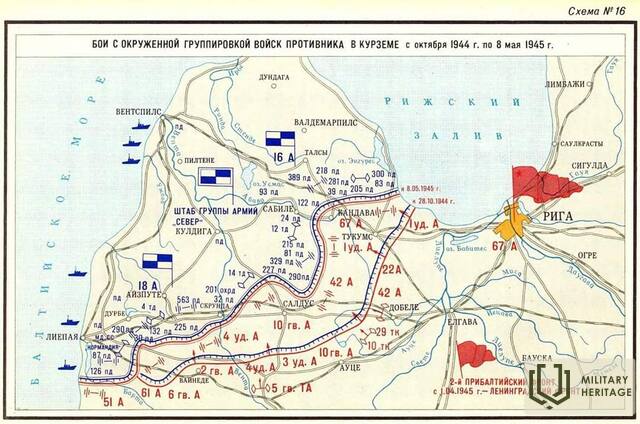

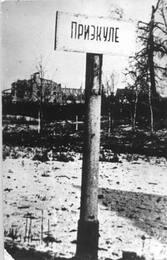

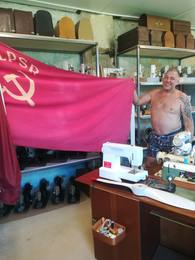
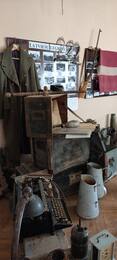
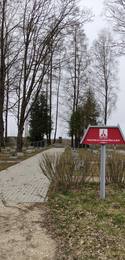
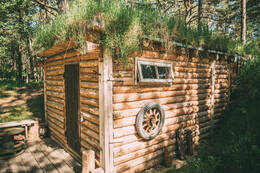
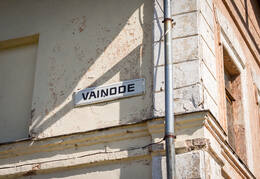
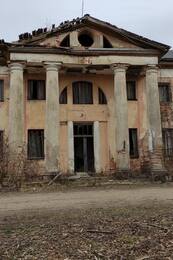
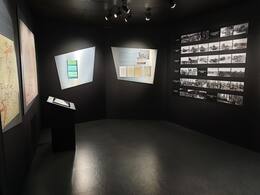
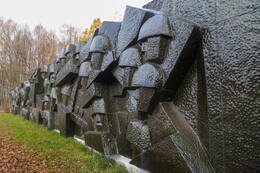
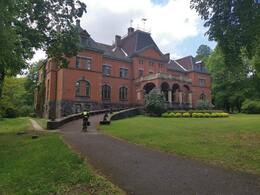
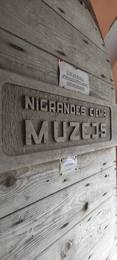
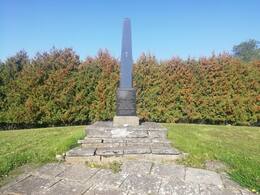
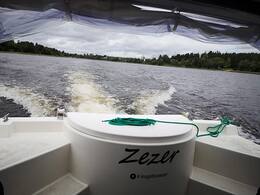
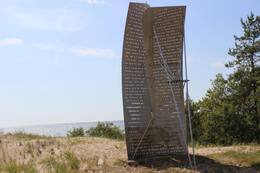
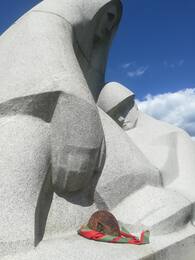
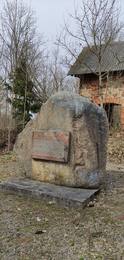
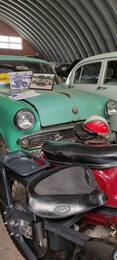
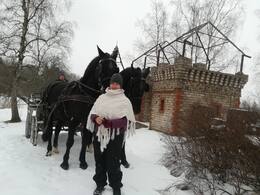
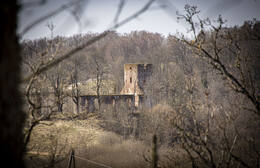
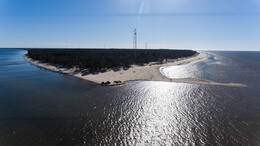
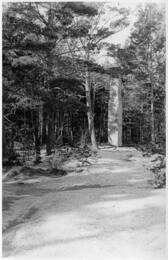
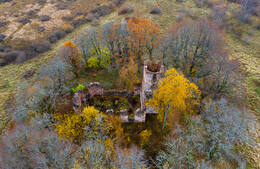
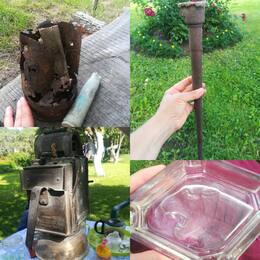
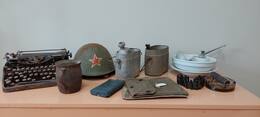
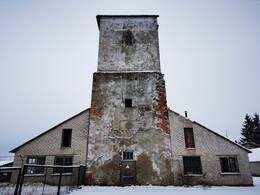
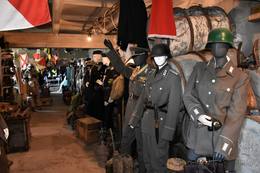
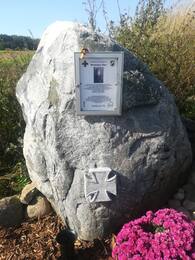
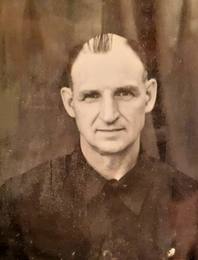


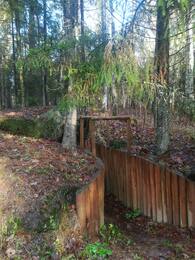
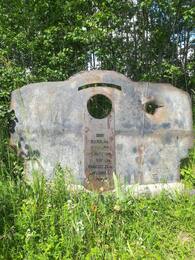
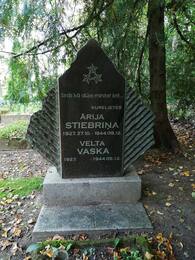
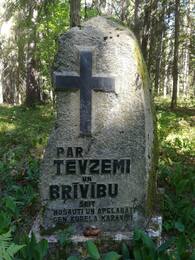
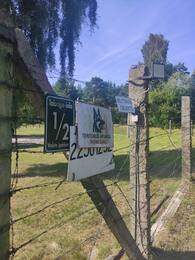

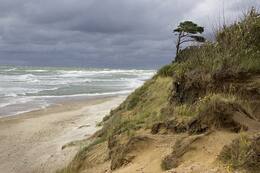
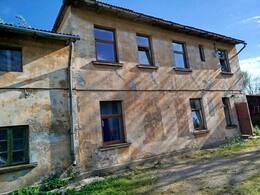
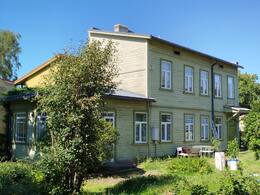
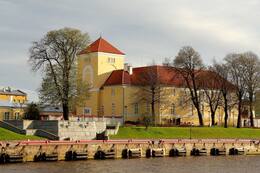
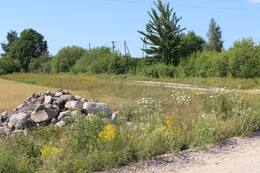

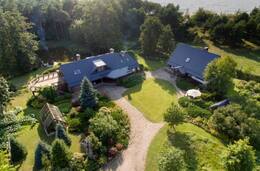
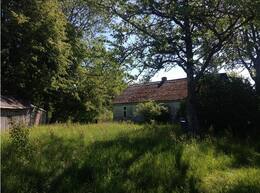
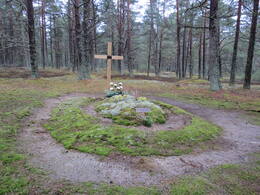
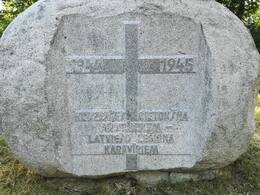

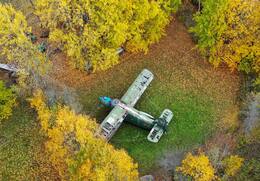
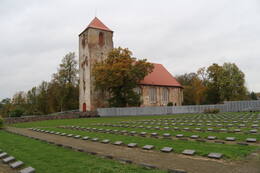
Please correct - the army group was called Courland.